Select Your Luggage Wheel Size
Luggage Wheel Size Details:
Small (2 – 3 inches)
Best for: Carry-on bags, compact luggage
Ideal Terrain: Smooth airport floors, flat surfaces
Advantages: Lightweight, compact, easy to store
Disadvantages: Struggles on rough or uneven terrain
Medium (3.5 – 4 inches)
Best for: Standard luggage, weekend bags
Ideal Terrain: Airport terminals, streets, light cobblestone
Advantages: Good maneuverability, balance of size and weight
Disadvantages: May struggle on rough surfaces over time
Large (4.5 – 5 inches)
Best for: Large checked luggage, travel bags
Ideal Terrain: Cobblestones, gravel paths, snow, outdoor terrain
Advantages: Smooth movement on rough terrain, stability
Disadvantages: Heavier, bulkier, takes up more space
Extra Large (5+ inches)
Best for: Heavy-duty luggage, large rolling bags
Ideal Terrain: Extreme outdoor terrain, rough roads
Advantages: Maximum stability and durability
Disadvantages: Heaviest, hardest to store, most expensive
Looking for the perfect fit? Check out these Best-Selling Luggage Wheel.
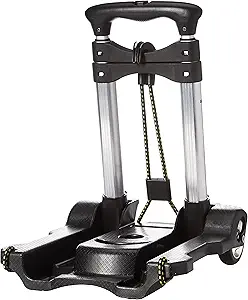
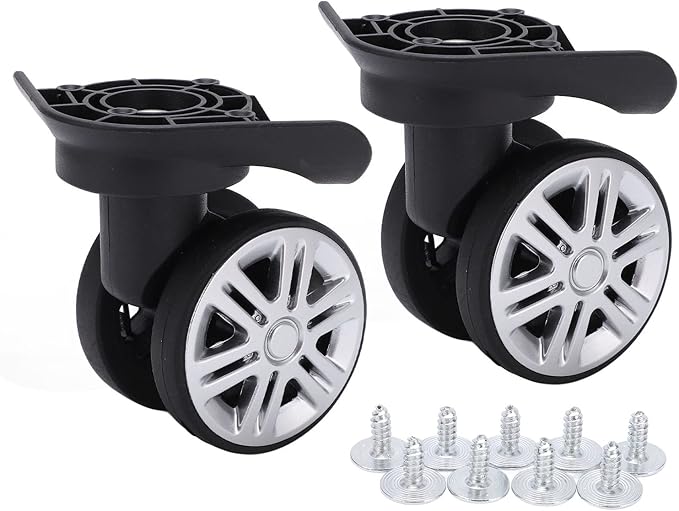
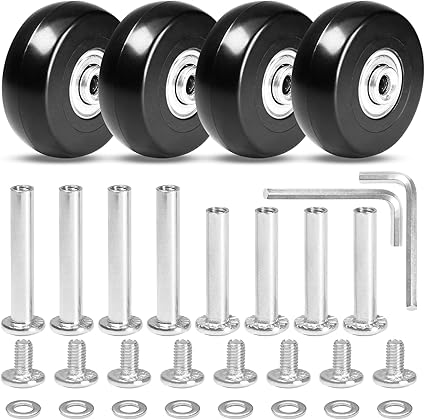
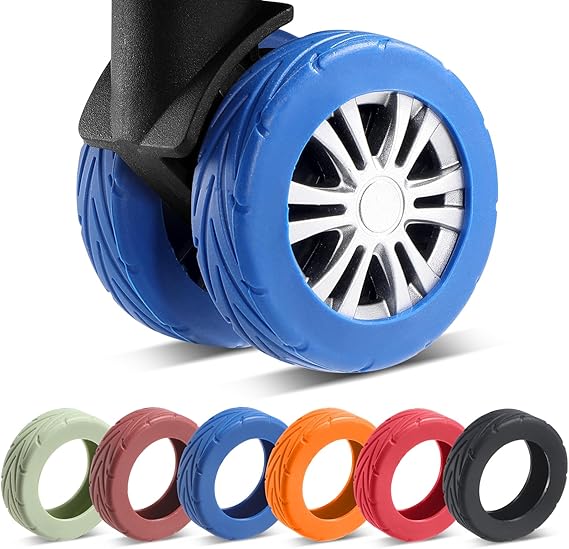
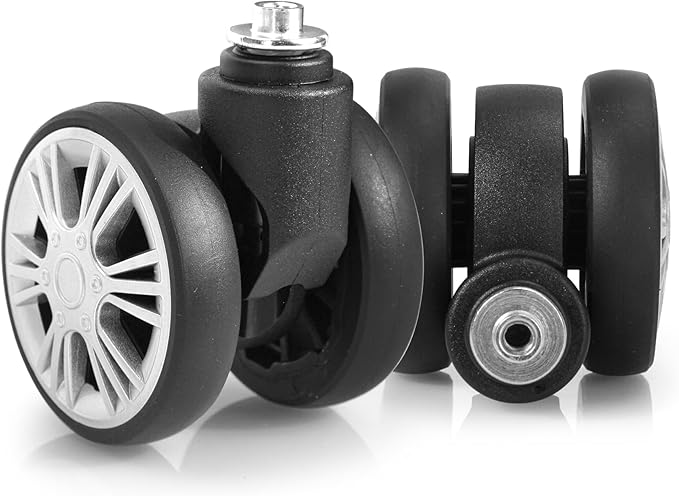
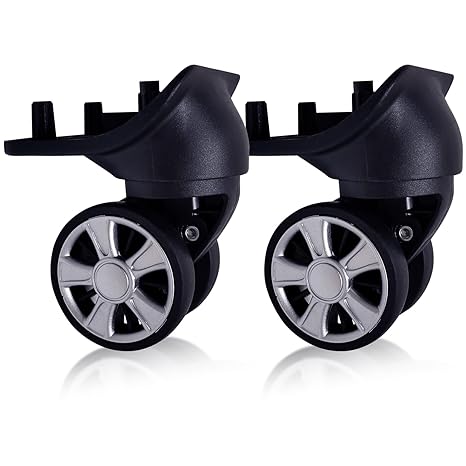
Luggage Wheel Size Guide - Choosing the Right Size for Smooth Travel
When it comes to selecting luggage for your travels, functionality is just as important as style. One of the most overlooked yet essential features of any suitcase or travel bag is the wheel size. Wheels are a crucial part of your luggage, determining how easy it is to move, maneuver, and transport your belongings. Whether you’re sprinting through airport terminals, navigating cobblestone streets, or storing your suitcase in overhead compartments, the size of your luggage wheels can make a world of difference.
We’ll delve deep into luggage wheel sizes, how they affect your travel experience, and provide a comprehensive luggage wheel size guide to help you make the best choice. From understanding the different wheel types to learning how to measure and select the right wheel size, this post has all the information you need to pick the ideal wheels for your suitcase.
The Importance of Luggage Wheel Size
Wheels are perhaps one of the most important components when selecting luggage. They not only make it easier to move your luggage around but also determine the overall durability and longevity of your suitcase. The size of the wheels can significantly impact how smoothly your luggage rolls, how stable it is, and how well it can withstand the rigors of travel.
When choosing the right luggage, you’ll come across a variety of wheel sizes, from small, compact wheels to large, robust ones. To make an informed decision, it's important to consider your travel habits, the type of terrain you'll be traveling on, and the amount of weight you’ll be carrying.
Types of Luggage Wheels
Before we get into the size guide, it’s important to understand that luggage wheels come in different styles. Each type of wheel is designed for a specific purpose, and choosing the right one will enhance your travel experience.
1. Two-Wheeled Luggage (Traditional Rollers)
Traditional two-wheeled luggage has wheels that are located only at the bottom of the bag. These bags require you to tilt them back to roll them, and while they are typically lightweight, they can be cumbersome in tight spaces or on uneven terrain.
- Best for: Light travel, smooth airport terminals, and paved surfaces.
- Advantages: More stable when upright, easy to maneuver on smooth surfaces.
- Disadvantages: Less maneuverable in tight spaces, harder to balance when standing.
2. Four-Wheeled Luggage (Spinners)
Four-wheeled luggage, or spinners, has wheels that rotate 360 degrees, allowing you to move the luggage effortlessly in any direction without tilting it. These bags are often more maneuverable and versatile, making them ideal for navigating crowded airports or shopping malls.
- Best for: Smooth, hard surfaces like airport terminals and hotel lobbies.
- Advantages: Easy to maneuver, can be rolled upright, spins 360 degrees.
- Disadvantages: Less stability when standing, prone to tipping over if overloaded.
3. Hybrid Luggage (Two-Wheel and Four-Wheel Combination)
Some luggage designs combine the benefits of both two-wheel and four-wheel systems. Hybrid luggage bags can be rolled like traditional two-wheeled bags, but the wheels can also rotate 360 degrees for added versatility.
- Best for: Travelers who want both stability and maneuverability.
- Advantages: Offers flexibility in movement and stability.
- Disadvantages: Heavier than two-wheeled bags, slightly bulkier.
How Luggage Wheel Size Affects Travel
The size of your luggage wheels will significantly influence how easy it is to move your luggage. Let’s break down how wheel size impacts your travel:
1. Maneuverability
Larger wheels tend to perform better on uneven surfaces, like cobblestone streets, gravel paths, or even snow. Smaller wheels, while more lightweight and compact, often struggle on rough terrain and require more effort to push or pull.
2. Stability
Luggage with large wheels is generally more stable, especially on four-wheeled bags (spinners). The bigger wheels can handle heavier loads and maintain stability even when the bag is in motion. Smaller wheels, especially on two-wheel designs, may not provide the same level of stability and could wobble when carrying a lot of weight.
3. Weight and Storage
Larger wheels are typically heavier and bulkier. This can be an issue if you’re traveling with weight restrictions or if you have limited storage space. Smaller wheels are more compact and lighter, making them ideal for carry-on bags and overhead compartment storage.
4. Durability
Wheel durability is largely affected by the material and size. Larger wheels are typically built to last and can withstand rougher conditions. Smaller wheels may be more prone to damage and wear over time, especially if the bag is frequently dragged on rough surfaces.
How to Measure Luggage Wheels
When selecting luggage, the size of the wheels is often mentioned in product descriptions. The measurement typically refers to the diameter of the wheel, which is essential for determining how large or small the wheels are. Here's how to measure luggage wheels accurately:
1. Measure the Diameter
To measure the size of your luggage wheels, you’ll need to measure the diameter of the wheel from the bottom to the top (excluding any axle or internal parts). Use a ruler or measuring tape to determine the distance from one side of the wheel to the other.
- Small wheels: Typically range from 2 to 3 inches (5-8 cm).
- Medium wheels: Range from 3.5 to 4 inches (9-10 cm).
- Large wheels: Range from 4.5 to 5 inches (11-13 cm) or larger.
2. Consider the Wheel Material
Wheel material plays an important role in durability and smoothness. Common wheel materials include:
- Rubber: Offers smooth, quiet rolling but may wear down faster on rough surfaces.
- Polycarbonate: Durable and resistant to rough conditions but may be noisier.
- Silicone or Gel: Ideal for shock absorption and smooth movement, especially on rough terrains.
Luggage Wheel Size Guide
To help you understand the different wheel sizes and how they suit various travel needs, here’s a comprehensive luggage wheel size guide:
| Wheel Size | Diameter | Best for | Ideal Terrain | Advantages | Disadvantages |
|---|---|---|---|---|---|
| Small Wheels | 2 to 3 inches (5 - 8 cm) | Carry-on bags, compact luggage | Smooth airport floors, flat surfaces | Lightweight, compact, easy to store | Struggles on rough or uneven terrain |
| Medium Wheels | 3.5 to 4 inches (9 - 10 cm) | Standard luggage, weekend bags | Airport terminals, streets, light cobblestone | Good maneuverability, balance of size and weight | May struggle on rough surfaces over time |
| Large Wheels | 4.5 to 5 inches (11 - 13 cm) | Large checked luggage, travel bags | Cobblestones, gravel paths, snow, outdoor terrain | Smooth movement on rough terrain, stability | Heavier, bulkier, takes up more space |
| Extra-Large Wheels | 5+ inches (13 cm+) | Heavy-duty luggage, large rolling bags | Extreme outdoor terrain, rough roads | Maximum stability and durability | Heaviest, hardest to store, most expensive |
Conclusion
Choosing the right luggage wheel size is an important decision for any traveler. While smaller wheels may offer compactness and lightweight benefits, larger wheels provide greater stability and ease of movement on rougher surfaces. Ultimately, the right wheel size depends on your travel style, the type of terrain you’ll be navigating, and the amount of luggage you need to carry.
By understanding the pros and cons of different wheel sizes and types, you can make a more informed choice and select the luggage that suits your needs. Whether you’re preparing for a short city break or a long journey across challenging terrain, the right wheels will make your travels smoother and more enjoyable.
Happy travels, and may your luggage roll with ease!
